I. Why I Switched to 40-50 lb Chicken Feeders for My Flock
Before we dive in, let me make this clear:
This article is for backyard chicken keepers with a medium-sized flock—around 10 to 30 chickens.
If you’re anything like me (and a lot of others), you’ve probably run into these issues before:
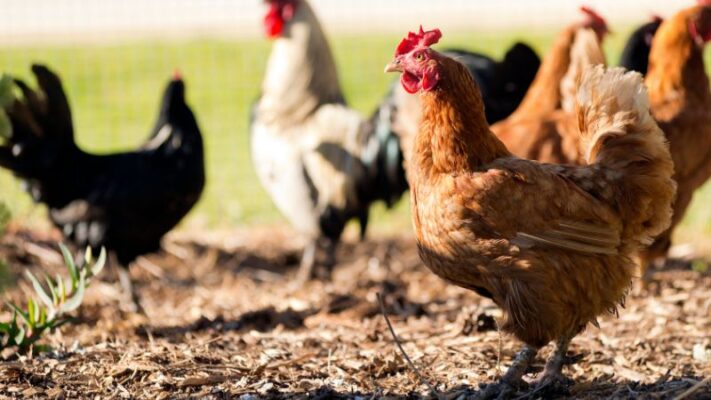
– Your flock is growing, but you’re still using a tiny feeder that only fits 2–3 chickens at a time.
– Chickens fight over food—strong ones bully the weak, and chaos breaks out in the coop.
– You live in an area with rats. Pick the wrong feeder, and the rodents eat before your chickens do.
– A sudden downpour hits, your feeder is outside, and now the feed is soggy and ruined.
– Cheap plastic feeder cracks after just a few months in the sun—back to square one.
– Worst of all: refilling and cleaning the feeder every single day when you barely have time.
Those small annoyances? They add up. Fast. And they wore me out.
Until I made one simple change: I switched to a 40–50 lb chicken feeder.
That one upgrade made a big difference—less daily worry, cleaner feeding, reduced waste, and a whole lot more free time.
II. Who Should Use a 40-50 lb Chicken Feeders ?
Before buying a 40–50 lb chicken feeder, there’s one very practical question you should ask:
How long will that feeder last for your flock?
To figure that out, start with how much feed your chickens eat per day. Here’s a quick reference chart based on age group—simple but super helpful when planning:
| Chicken Age | Type | Feed per Bird/Day | Feed for 10 Chickens | How Long 50 lb Will Last |
| 7–12 weeks | Growers | ~0.25 lb | 2.5 lb | ~20 days |
| 12–20 weeks | Pullets | ~0.3 lb | 3 lb | ~16–17 days |
| Adults | Layers / Broilers | ~0.4–0.5 lb | 4–5 lb | ~10–12 days |
So, if you’ve got 15 adult chickens eating around 6–8 lb/day, a 50 lb feeder will last roughly 7–8 days.
This is just an estimate, but it helps you plan ahead and choose the right size feeder for your needs.
Based on that, here’s who should consider a 40–50 lb chicken feeder:
✅ You’re raising chickens aged 7 weeks and older
At this stage, they start eating much more, and those tiny chick feeders just won’t cut it.
A 40-50 lb feeder works well from grower feed stage all the way to laying or meat production.
✅ You’ve got 10–25 pullets or adult hens
This is the most common flock size for backyard chicken keepers in the U.S.
Smaller feeders need constant refilling; larger ones can be overkill.
A 40-50 lb chicken feeder hits that sweet spot—enough for 10–20 days depending on age and size.
✅ You can’t (or don’t want to) feed them every day
If you work full-time or only have time for the coop early morning or late evening, a large-capacity feeder saves a ton of effort.
It even gives you peace of mind when you’re away for a few days.
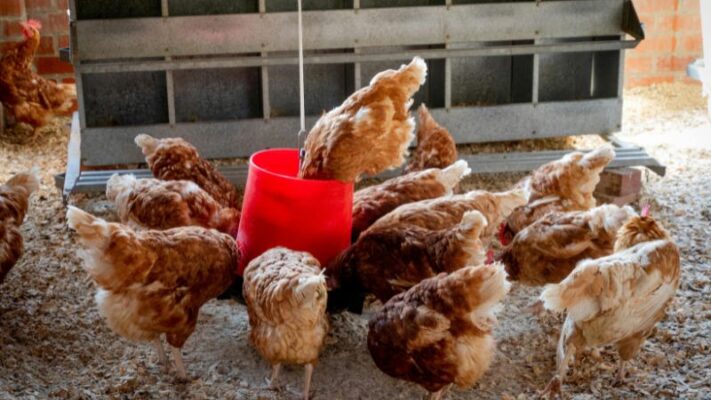
✅ Your chickens free-range or live in a larger coop
With more space between your home, the feed shed, and the coop, constant trips get tiring.
A larger feeder reduces the back-and-forth—especially helpful in rainy or wintery weather.
✅ You raise chickens for eggs or meat for your family—not commercially
If you’re focused on self-sufficiency, then convenience, durability, and feed protection matter more than high-tech equipment.
A 40–50 lb chicken feeder checks all those boxes—no fancy systems needed.
If you nodded yes to 3 out of 5 of the above, chances are you’re wasting time every day just keeping the feeder full.
This article will help you pick a feeder that’s cleaner, more efficient, and way easier to manage.
III. Popular Types of 40–50 lb Chicken Feeders – Pros & Cons
When choosing a feeder for your backyard flock of 10–30 chickens, especially a 40–50 lb feeder, size isn’t the only thing that matters. You also need to consider how you raise your chickens, where the feeder will be placed, and other factors like whether your coop is enclosed or outdoors, and whether rodents are a problem in your area.
Here’s a breakdown of the most common types of 40–50 lb chicken feeders available today. We’ll group them by how they work and what materials they’re made of—along with real-world pros and cons for each.
📌 Classified by Feeding Mechanism
| Feeder Type | How It Works | Pros | Cons |
| Treadle Feeder | Chickens step on a platform to open the lid and access feed | – Rodent- and bird-proof – Reduces waste and spillage |
– Chickens need time to learn how to use it – Not ideal for small chicks |
| Gravity Feeder | Feed flows down naturally into the tray | – Easy to use – Affordable and widely available |
– Rodents and chickens can access easily – Feed often gets scattered |
| Hopper Box | Enclosed bin with feed sliding into a tray | – Compact and sealed – Good rain protection – Works indoors or out |
– Some models clog with fine feed or crumble |
| Wall-Mounted | Installed on coop wall or fence | – Saves floor space – Easier to clean underneath |
– Fewer models offer full 50 lb capacity – Harder to refill if mounted high |
💡 Tip: If you’re dealing with a serious rodent problem, a treadle feeder is practically a must. For free-range chickens, gravity feeders are easier to place and replace. If your flock lives in a large coop, hopper boxes or wall-mounted options can help you keep things tidy and efficient.
🧱 Classified by Material
| Material | Pros | Cons |
| Galvanized Metal | – Extremely durable – Weather-resistant – Rodent-resistant |
– Heavier than plastic – Can get hot in direct summer sun |
| High-Grade HDPE Plastic | – Lightweight – Easy to clean – Rust-proof – Great for indoor/outdoor use |
– Thin plastic models may become brittle over time |
| Aluminum / Powder-Coated Steel | – Lighter than regular metal – Better rust resistance |
– Can dent or warp if dropped or hit |
| Wood | – Aesthetic appeal – DIY-friendly |
– Absorbs moisture – Mold risk – Harder to sanitize long-term |
✅ Note: High-quality plastic feeders (thick HDPE or ABS) are super popular because they strike a great balance between price, durability, and ease of use. But if your feeder is going to sit outside all year round, a good galvanized metal option still wins for long-term toughness.
👉 Next, let’s go over the key things to watch out for before you buy—so you don’t end up wasting money on a 50 lb chicken feeder that just doesn’t work for your setup.
IV. Things to Watch Out For Before Buying a 40–50 lb Chicken Feeder
A bigger feeder or a rodent-proof one isn’t necessarily better. The best feeder is the one that fits your chicken coop setup. Here are some important points you absolutely need to consider before hitting that “Buy Now” button:
1. Will the Feeder Be Placed Inside the Coop or Out in the Run?
Where you place your feeder directly affects its durability and your flock’s health. Each location comes with different challenges:
🐔 If placing it inside the coop:
• Make sure there’s enough space for both the feeder and easy access for your chickens.
• 50 lb feeders are often large and bulky—double-check the dimensions before buying.
• The big plus here is weather protection: no rain, less need to move it around.
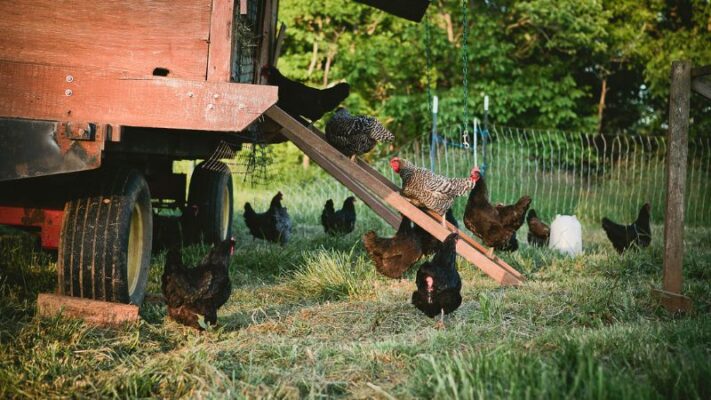
🌦️ If placing it out in the run:
Ask yourself: is the area well-prepared?
• Is there a roof or any cover?
• Will the chickens still be able to eat when it rains?
• Is your feeder water-resistant, or will you need to build extra protection?
📦 Portability – often overlooked:
• Some large feeders become extremely heavy and awkward once filled. If you live in an area with unpredictable weather, prioritize feeders that have handles, are lightweight when empty, or have easy-to-disassemble designs.
• Being able to move your feeder quickly can save your feed from getting soaked or wasted.
📌 Pro tips:
• If your run doesn’t have a roof, avoid open-top gravity feeders—just one light rain can ruin your feed.
• Enclosed hopper-style feeders or those with slanted roofs are better for outdoor use.
• Planning to keep it outdoors long-term? Go for weather-resistant materials like HDPE plastic or galvanized metal—they’re easy to clean and can handle the elements.
⚠️ Health warning:
Chickens are highly vulnerable to illness from eating wet or moldy feed or getting soaked while eating. If you can’t guarantee dry ground and cover, choose a water-resistant feeder with high mobility so you can move it as needed.
2. Mounting Style: Wall-Mounted or Ground-Based?
• Ground-based feeders → Must be stable. Chickens will jostle and push while eating, so the feeder should not tip over.
• Wall-mounted feeders → Your coop needs strong, stable walls. A fully-loaded 50 lb feeder must be securely screwed into place.
• Freestanding feeders with legs → These are convenient and easy to reposition, but make sure the legs are sturdy enough to withstand bumping from active chickens.
📌 Pro tip: Don’t hang your feeder too high—your chickens won’t reach it easily or will end up pecking at the feed that drops instead of eating directly. We recommend placing it directly on the ground or using a freestanding model.
3. Your Local Weather & Climate Conditions
If you live somewhere with extreme weather—very hot summers or freezing winters—avoid cheap feeders made from flimsy materials. These often can’t handle temperature changes and may crack, warp, or rust over time, creating safety issues for your flock.
📌 Best bet: High-quality HDPE plastic or powder-coated steel. No overhead cover? Choose a feeder with a tight lid or sloped roof design.
4. Rodents & Wild Chickens – The Unexpected Feed Thieves
If your feeder mysteriously empties overnight, chances are it’s not just your chickens. In areas with lots of pests, open-top gravity or hopper feeders are almost useless—they expose the feed too easily.

📌 Best option:
• A treadle feeder is ideal here. It opens only when a chicken steps on the platform—mice and small chickens aren’t heavy enough to trigger it.
• Not using a treadle? Make sure your feeder has a locking lid, weight-triggered access, or is mounted high enough that rodents can’t reach.
👉 Want a deeper look? Check out our detailed guide:
Best Rat Proof Chicken Feeder for Backyard Coops – where we break down the most effective rodent-proof feeder options.
5. Ease of Cleaning – Don’t Overlook This
• If you’re short on free time, feeders that are hard to take apart and wash will become a hassle—and you’ll start putting off cleanings until the feeder grows mold.
• Moist feed can quickly turn moldy → causing diarrhea, stunted growth, or even death.
📌 Smart picks: Choose feeders with easy-to-remove trays, minimal crevices, and ones that can handle a pressure hose without falling apart.
6. Planning to Expand Your Flock Soon?
A 50 lb feeder typically supports 10–20 adult chickens. But if you’re planning to hatch chicks or buy more chickens, it’s wise to think ahead.
📌 Long-term strategy:
• Buying two medium-sized feeders offers more flexibility than one oversized one. It reduces mealtime crowding and gives you options when rearranging your setup.
• Some models let you attach add-on trays to expand feeding space—consider those from the start.
✅ Bottom Line:
Choosing the right chicken feeder isn’t just about how much feed it holds. It depends on how you raise your chickens, where the feeder will sit, your local weather, rodent threats, and your available time.
Don’t rush it—let the feeder work for you, not the other way around.
V. Top 3 Chicken Feeders with 40-50 lb Capacity I’ve Chosen and Reviewed
1. OverEZ Chicken Feeder – 50 lb Capacity, Recycled Plastic, 3 Feeding Ports
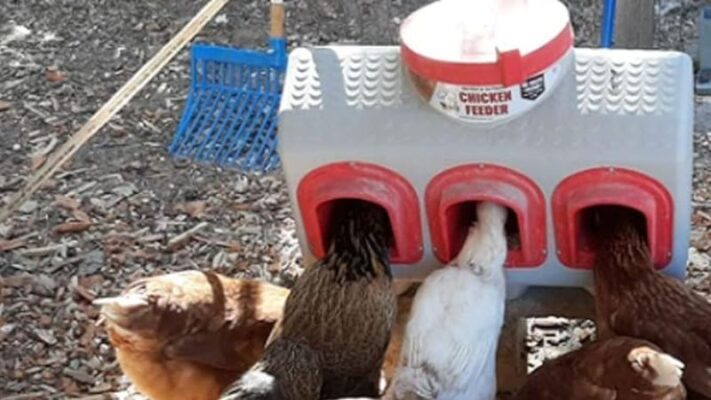
Pros:
✔️ Enclosed design keeps rain out and reduces feed waste
✔️ Made of safe, recycled plastic; easy to clean
✔️ Can be installed permanently or moved as needed
Cons:
❌ No effective rodent-proof mechanism—must be placed in a safe area
❌ May become crowded during peak feeding times with more than 15 chickens
👉 Check the latest price and buy OverEZ Chicken Feeder here!
2. GSHWXD Galvanized Feeder – 40 lb Capacity, Galvanized Metal, 6 Feeding Ports

Pros:
✔️ Sturdy, rust-resistant material handles all weather
✔️ Covered feed area keeps out rain and mold
✔️ Rodent-resistant design saves feed
✔️ Easy to clean and move
✔️ Suitable for flocks of up to 20 chickens
Cons:
❌ Higher price point—but worth it for the quality
👉 See price and order the durable GSHWXD feeder here!
3. DARNEFEN Chicken Feeder – 40 lb Capacity, Galvanized Metal, 6 Feeding Ports
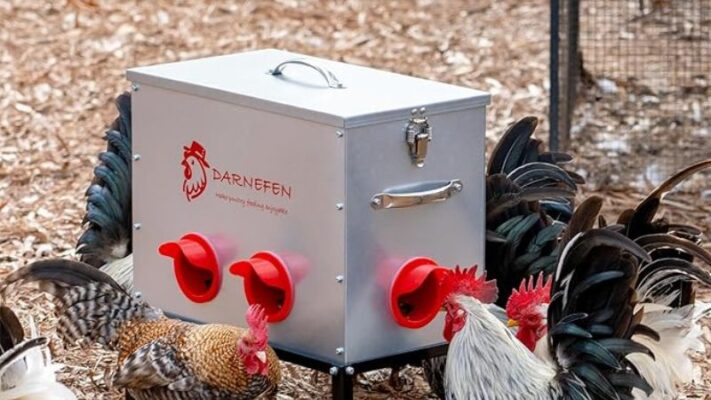
Pros:
✔️ Similar to the GSHWXD model: weather-resistant, feed-saving, easy to clean, rodent-resistant, portable
✔️ Works well for flocks up to 20 chickens
Cons:
❌ Also in the premium price range—but offers long-term durability and consistent performance
👉 Check current price & buy DARNEFEN Feeder here!
Quick Comparison Table
| Product Name | Capacity | Material | Feeding Ports | Rodent-Proof | Price |
| OverEZ Chicken Feeder | 50 lb | Recycled Plastic | 3 | ❌ | Around $70–$90 |
| GSHWXD Galvanized Feeder | 40 lb | Galvanized Metal | 6 | ✅ | Around $110–$150 |
| DARNEFEN Chicken Feeder | 40 lb | Galvanized Metal | 6 | ✅ | Around $110–$150 |
VI. Real-Life Tips to Make Feeding Easier!
Here are some simple yet surprisingly effective tips when using large-capacity chicken feeders for your backyard flock:
🐣 1. Don’t Fill the Feeder to the Max
Yes, the feeder is designed for 50 lbs, but that doesn’t mean you should always fill it up. If you’re not away for several days, filling it halfway is often better.
– Fresh feed is tastier and cleaner for your chickens.
– Leaving feed out overnight can attract rats or other pests.
🔍 2. Add a Cover or Shield If Needed
Even if the feeder says “weather-resistant,” it’s worth checking in real life:
– Is rain getting in from the sides?
– Are there gaps where water might seep in?
Many outdoor users add a plastic sheet, tin roof, or even a patio umbrella to protect both the feeder and the flock.
🧼 3. Set a Cleaning Schedule
You don’t have to clean it daily, but at least every 1–2 weeks you should:
– Disassemble the tray
– Let it dry in the sun
– Scrape off any build-up to prevent mold and flies
Pro tip: A mix of warm water and white vinegar is a great natural cleaner and deodorizer.
📏 4. Label Feed Levels
Marking the inside of the feeder with simple lines (e.g., 20 lb, 40 lb) can help you eyeball how much feed is left—without lifting or guessing.
🧠 5. Check After the First Week
Ask yourself:
– Are the chickens finishing the feed?
– Is any feeder clogged?
– Is any bird being left out or unable to access the feed?
These small observations can help you adjust the feeder height, move its position—or even switch to a better-suited model!
VII. Final Thoughts: Choosing a Large Feeder Isn’t Hard—As Long As You Know What You Need
Investing in a 40-50 lb feeder can save you time, reduce feed waste, and help your flock grow stronger—as long as you choose one that fits your setup, your chicken count, and… your local rat problem.
Want to explore the best feeder models for your needs? Check out our comparison charts and in-depth reviews right here: Chicken Feeder Guide: How to Choose the Right Feeder for Your Backyard Flock
👉 What feeder are you using for your chickens?
Share your experience in the comments below—we’d love to hear your tips and help other backyard keepers!

